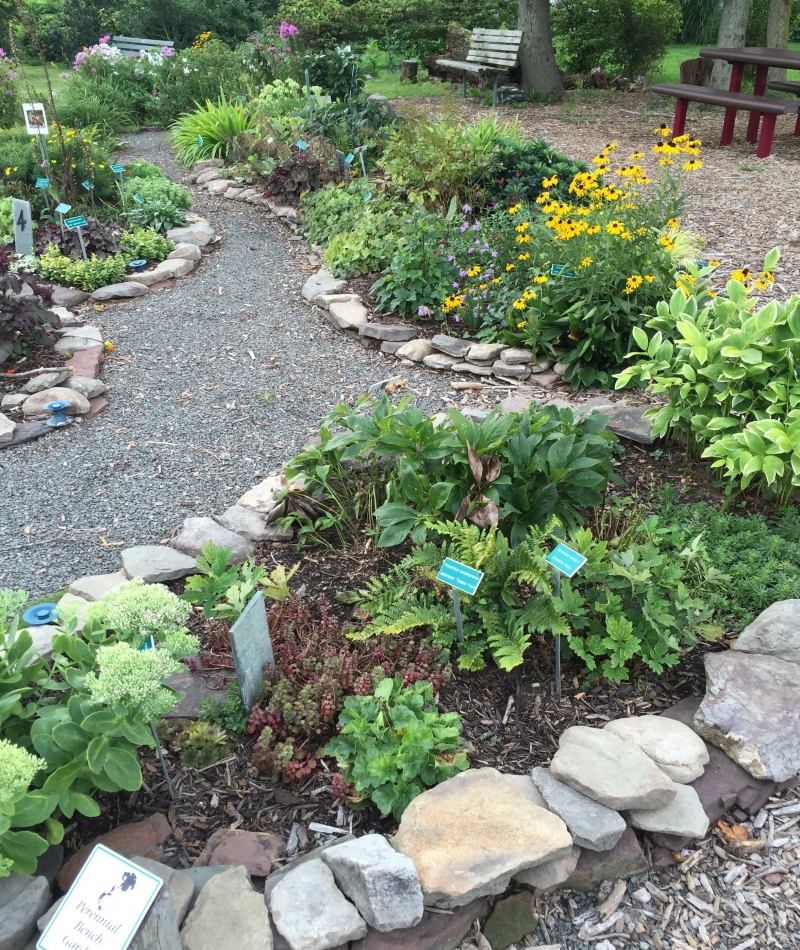STEPS TO CREATING A PERENNIAL GARDEN
What you see before you is an example of a perennial garden. These hardy plants come back each spring, year after year, as opposed to annuals that die with the first killing frost in the fall. If you are interested in learning more about this type of garden, read on for some helpful suggestions on how you too can create a perennial garden. Also, take a walk around the garden to look for any ideas, especially suggestions for plants, which you may take with you.
Step One: Identify a site for the garden with consideration for sunshine, shade, and moisture.
- Determine if it is a sunny site (more than 6 hours of sun), or a partial shady site (3-6 hours of sun), or a shade site (less than 3 hours of sun).
- Determine if it is a dry site or a moist site. Often the area under a tree is a dry site. Trees are bigger than plants and drink first. Moist sites are often in drainage areas, which experience runoff. Of course nature can influence the amount of moisture in the soil by providing too much or too little rainfall.
Step Two: Prepare the soil.
- Have a soil test done to evaluate what nutrients need to be added.
- Add compost to the soil to increase the nutrients, increase aeration, and improve drainage.
- After planting, add 1-2 inches of mulch for additional moisture retention and weed control.
- When working under trees, be careful not to disturb the tree roots or add too much soil or compost, which will smother the roots.
Step Three: Select the right plant for the right spot.
- The key to success is the selection of appropriate plants for the site, by taking into consideration whether the site is sunny or shady and dry or wet.
- Take note of color, size, texture, and foliage in planning your garden.
- Try to select a variety of plants that will give you blooms throughout the season.
- Plant lists for specific growing conditions can be obtained at the Mercer County Extension Office in Trenton.
- Note the following plant suggestions with site and season specified in the chart.
Step Four: Watering Practices
- New plants in particular need deep watering to get the roots established.
- Weekly deep watering is better than more frequent shallow watering, which will result in weak shallow roots.
- A soaker hose works wonders and saves time and backs.
- Mulch, mulch, mulch to retain moisture.
PLANT SUGGESTIONS
| Galanthus | Snow drops | Dry shade | Spring bulb |
| Eranthus | Aconites | Dry shade | Spring bulb |
| Mertensia | Virginia bluebells | Dry shade | Spring ephemeral |
| Hellebores | Hellebore | Dry shade | Early spring |
| Convallaria | Lily-of-the-valley | Dry shade | Spring |
| Epimedium | Barrenwort | Dry shade | Spring |
| Galium | Sweet woodruff | Dry shade | Spring |
| Astilbe | Astilbe | Moist shade | Summer |
| Asarum | Wild ginger | Moist shade | Spring |
| Chelone | Turtlehead | Moist shade | Summer |
| Arisaema triphyllum | Jack-in-the-pulpit | Moist shade | Spring |
| Cimicifuga racemosa | Bugbane | Moist shade | Fall |
| Caltha palustris | Marsh marigold | Moist sun | Spring |
| Iris kaempferi | Japanese iris | Moist sun | Summer |
| Eupatorium | Joe Pye weed | Moist sun | Fall |
| Crocus | Crocus | Dry sun | Spring |
| Heuchera | Coral bells | Dry sun | Spring |
| Baptisia | False indigo | Dry sun | Summer |
| Echinacea | Cone flower | Dry sun | Summer |
| Aster laevis | Smooth aster | Dry sun | Late summer |
| Coreopsis verticillata | Threadleaf coreopsis | Dry sun | Late summer |
| Sedum spectabile | Sedum | Dry sun | Fall |
In addition to the plants listed above, take a look at each bed in the Perennial Garden for other plant suggestions. The orientation is from the main walking path between the Annual Garden and the Perennial Garden.
- Bed 1 has dry shade on the left and moist shade on the right.
- Bed 2 has dry sun on the left and moist sun on the right.
- Bed 3 has dry sun in the front and dry shade in the back.
- Bed 4 has dry shade on the left and moist sun on the right.
- Bed 5 has dappled sun.
- Bed 6 has dry shade.
RULES OF THUMB TO GARDEN BY
- Planning is the first step in having a lovely garden.
- Have a soil test done for evaluation of the nutrients present and if any amendments are necessary.
- Proper soil preparation is vital. Organic amendments help with fertility, drainage, and aeration.
- Choosing the right plant for the right location is a must.
- Pruning, deadheading, and pinching are necessary to prolong bloom.
- Plants for foliage interest are welcome additions.
- Varying the height and width of plants is as important as deciding on a color palette.
- Deep watering at least once a week will maintain the vigor of the garden.
- Fertilization early in the spring and late in the fall is necessary.
- And most importantly remember to ENJOY YOUR GARDEN. Thank you for visiting ours.

